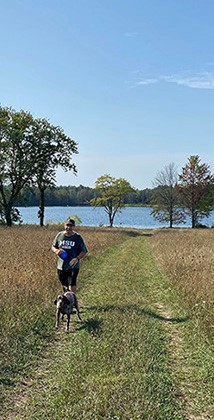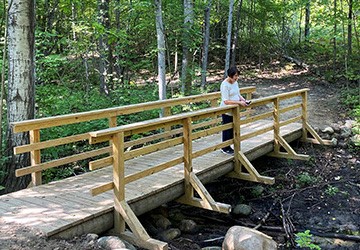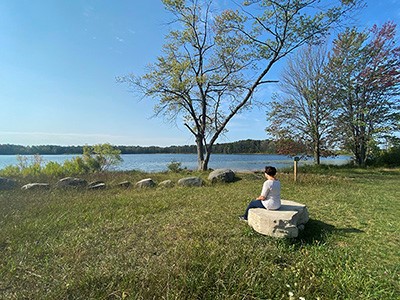By JIM DuFRESNE
Capital News Service
KEWADIN — In a ravine below me, something was walking through the woods.
I stopped to peer down through the trees, but I already knew it wasn’t summer campers. It’s been 10 years since children and counselors gathered at Maplehurst for hikes, stargazing and campfire singalongs in northern Michigan.

Jim DuFresne/ michigantrailmaps.com
Dog walking in Maplehurst Natural Area.
It was whitetail deer. A lot of them, six or seven at least. They also stopped and looked up, and for a brief moment we stared at each other – Maplehurst’s current residents and the latest hiker to be charmed by this relatively obscure preserve northeast of Kewadin.
Kumbaya.
Located on that strip of land that separates two of Michigan’s largest lakes, Elk and Torch, Maplehurst Natural Area is an unexpected delight to anybody who stumbles across it.
You’re driving through rural Antrim County, passing perfect rows of cherry and apple orchards, faded red barns and farm stands overloaded with just-picked produce, when a sign beckons you to leave the pavement and enter a forest.
The short entrance road climbs to the highest point in the preserve, where you can see the north end of Elk Lake, East Grand Traverse Bay and even a slice of Mission Peninsula from a parking area.
A grassy meadow, where sleeping cabins once stood, gently descends to even more water – the tract’s 60-acre spring-fed gem, Lake Maplehurst.
Who wouldn’t want to spend a summer here?
For more than 50 years, this 389-acre mix of woods and watery views was Camp Maplehurst, founded by psychology professor Thomas Cohn in 1955 as a retreat where gifted students could experience nature.
By 2011, when Cohn’s son closed the summer camp due to declining enrollment, Maplehurst had hosted more than 10,000 campers.
Milton Township officials viewed the shuttered camp, one of the largest remaining undeveloped parcels near Torch Lake, as worth saving from development.
They turned to the Grand Traverse Regional Land Conservancy, which helped the township secure a Michigan Natural Resources Trust Fund grant, and then fundraised the grant’s required match.
“We had previously identified the Maplehurst Camp property as a priority (to preserve), but we were unsure of how we could pull it off,” said Chris Garrock, the director of stewardship for the land conservancy.
“We were elated when Milton Township reached out and expressed interest in partnering with us to acquire and protect the property as a township park,” Garrock said.
This old summer camp makes for a wonderful walk.
Maplehurst Natural Area opened in 2019, featuring a 5.6-mile, multi-loop trail system that makes the most of its unusually rugged terrain, while Lake Maplehurst is once again a destination for canoers, kayakers and other nonmotorized boaters.

Jim DuFresne/ michigantrailmaps.com
A hiker stops to look at a small stream in Maplehurst Natural Area.
The perimeter of the trail system is a 3.8-mile outing that includes parts of all four loops and leads to every corner of the preserve. Begin with the west half of the Ridge Trail Loop, a gentle but steady descent with a constant view of lakes and the bay.
When you bottom out, skirt the wooded shoreline of Lake Maplehurst and then merge into the Forest Trail, the most interesting segment of the system.
Maplehurst’s camp trails were old two-tracks that today are slowly being absorbed by shrubs and saplings.
The Grand Traverse Regional Land Conservancy used some of them in designing the current system, but most of the trails are new, built by volunteers and contractors with a focus on sustainability and fun.
The Forest Trail delivers that whether on foot or on a mountain bike.
You quickly climb to the crest of a ridge that’s so narrow you can look into the wooded ravines on both sides without turning your head. You then catch a blue glimpse of Torch Lake through the trees just before the trail makes a sharp 180-degree turn.
The next mile, past posts No. 5 and 6, is a roller coaster in the woods.
While overall, you’re descending, the trail does so by sidling ridges. You’re dipping, climbing and weaving back and forth until you finally bottom out at one of the many stone benches along the paths.
You’ve only 2 miles from the trailhead, but you take a break anyhow.
At post No. 7, you pop out at Torch Lake Drive. On the other side are impressive waterfront cottages. Just up the road, the well-posted Stream Trail leaves the pavement and re-enters the rolling forest to lead back to your car.
Stream Trail is well named.
Almost half of Maplehurst is composed of steep hardwood-forested bluffs, and on the east side of the preserve, the ridges are riddled with seeps, springs and streams that drain into Torch Lake.
You may be only a few hundred yards from Michigan’s largest inland lake, but the terrain is so rugged and the foliage so thick that what you hear isn’t jet skis or pontoon boats. What fills the forest along this trail is a gurgling brook below and the wind rustling leaves above.
While all four loops at Maplehurst were designed primarily for hiking and off-road cycling, portions are suitable for cross-country skiing and snowshoeing in the winter.

Jim DuFresne/ michigantrailmaps.com
A scenic resting point in Maplehurst Natural Area.
But the best time of the year to stumble on this tract is now, when those hardwood leaves catch fire and then begin dropping, turning blue glimpses of lakes into views that make you pause and ponder the enduring legacy of this summer camp.
Jim DuFresne of Michigantrailmaps.com is an MSU Journalism School alum.